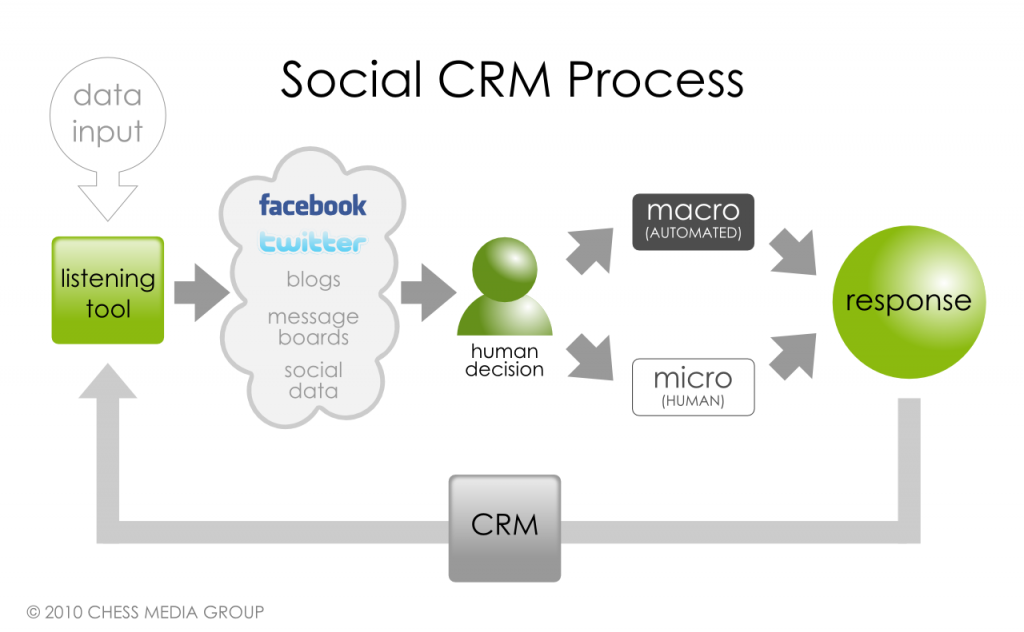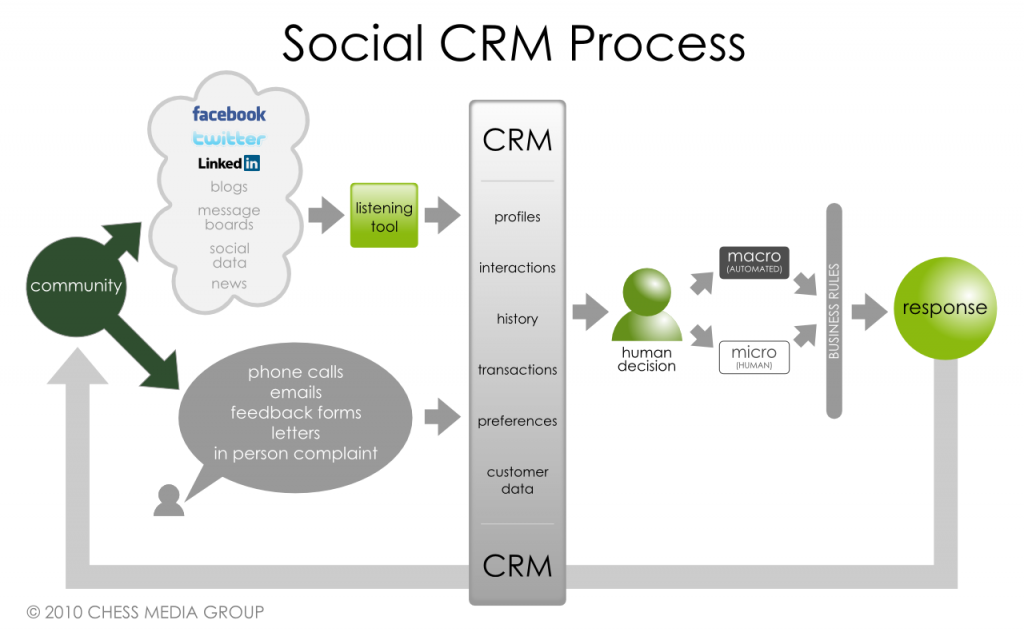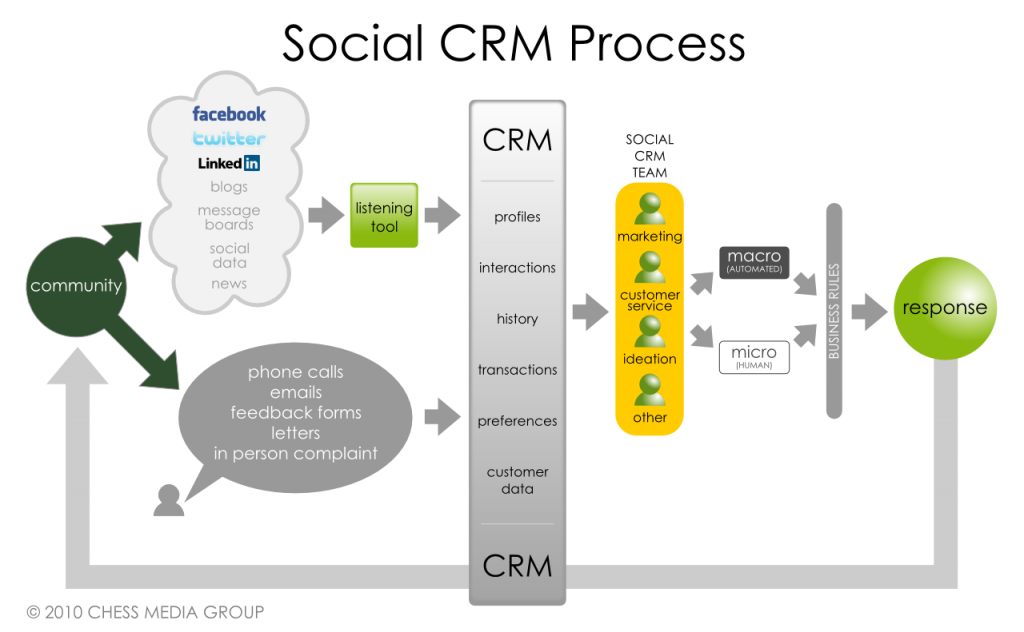A few weeks ago I wrote about the Social CRM Process (read this first before moving on) which received quite a lot of attention and feedback from the online community. The process that I have created has since evolved to incorporate some additional ideas and elements which were originally missing. I incorporated some feedback from the online community and specifically from my colleagues such as Mitch Lieberman and Esteban Kolsky. If you recall, the original social CRM process looked like this:

I thought this was a great starting point (which it was) but there were a few key things missing here. Take a moment and see if you can figure it out before moving on.
I think the biggest issue with the above process diagram is that it makes the assumption that social CRM is all about social media, which is absolutely false.
Read my recap of Paul Greenberg’s Social CRM keynote to see how he helped create a SCRM strategy without using any type of social media/networks. Social CRM is first and foremost a strategy; the technology piece always plays second fiddle. The next addition in the process is the CRM system, which actually needs to come into play in two parts (not one as seen above) of the process; once before the information gets to the human making the decision and then again after the response has been sent out. Finally, the addition of “business rules” to help govern and dictate the response was also missing. So taking all of these things into consideration (with a few other minor tweaks), the new social CRM process looks like this:

Let’s walk through this diagram quickly:
Here we can see that the customer can either exist online OR OFFLINE and once the “issue” is present it goes through the CRM system where the person responsible for making the decision gets valuable information about the customer BEFORE making any type of decision. Some of the information (thanks to Mitch Lieberman) included is:
- customer profile (online/offline)
- previous interactions
- customer history
- customer transactions
- customer preferences
- and other customer data
Once the employee has this information, he/she is now able to follow the business rules, which will dictate how the response is crafted and then sent out. Once the response is sent out (either macro or micro) the information is then once again fed back into the CRM system to capture the interaction and thus closing the CRM loop. The response is then fed back out into the community (or individual) and the process can continue.
I wanted to take this one step further and decided to introduce what I believe is going to be a crucial element of social CRM strategies in the future, the SCRM team. I think the “social media team” is going to become irrelevant as companies realize that the value of these strategies and technologies is not in promoting, selling, or building a network, but in collaborating with the customer and improving the overall experience. The people responsible for executing these strategies are not going to be people that understand social media but people that understand social media, the customer experience, CRM (among other things), and how this all fits together (I’ll have a separate post on this). See below:
Keep in mind that in order for this to work, social media/monitoring tools in the space are going to have to improve their semantic analysis and will need to be able to distinguish between various “issues” that exist. For example the difference between a marketing issue and a support issue. The goal here is to automatically route issues to the proper person in the proper team instead of having one person act as the funnel. Is this going to be possible in the future? Sure, I think so, but I don’t think we are there yet (read our partner Biz 360s post on sentiment analysis via Mashable).
There are other changes and additions that can be made to the Social CRM Process but Mitch Lieberman hit the nail on the head when he said:
“…anyone should be able to take his diagram and use it as a baseline model (not as a best practice) and move the arrows, fill in the boxes and make it work for your business.”
Of course, this is easier said than done (you can hire me and my company for that) but the idea is that companies need to map out their own process which will probably require some form of an assessment to see what is your company’s current state. Once the new Chess Media Group site launches, we will incorporate our new list of SCRM services which will include (most likely) an assessment and process mapping phase.
There is one other issue with the diagram above. Can you figure it out?
Look at where everything starts, everything starts with the community and then moves to the organization. This puts the organization into a reactive role (something Brent Leary was keen on pointing out when I spoke with him). What happens when it’s the company that initiates the conversation and not the community? That’s a pro-active model and requires a separate process map. I will address this and create a visual map for it in the future.
Thoughts, ideas, comments? What do you think about the new process flow and thanks for your feedback!


Jacob, may be its my BPM background, but I see your #SCRM diagram predominantly as a data flow rather than a process diagram. I don't see any activities in the diagram, except for the one place where you had depicted Human Decision. And to my BPM tainted mind, that doesn't come out as a Process. 🙁
Also, wrt the channels, Data Flow, integrations, etc. that you have depicted in the diagram, why is there only a listening tool as an interface/integrator to/with CRM data? The various social sites have APIs galore that can be used for direct integration with the CRM data. OpenID, OAuth, Facebook/Google Connect, XAuth, etc. can all be included there, which will not go through a listening tool.
And in the Listening Tool itself, why are you restricting to Sentiment Analysis? It is but a very small subsection of Text Mining/NLP, more appropriately called Opinion Mining. Without other aspects of text mining, you are severely limiting the possibilities. Sentiment Analysis by itself cannot tell you if its a Marketing or a Customer Service issue, various other aspects of Text Mining can.
Just my two cents & IMHO only. If I have understood your diagram wrongly or misrepresenting anything, pls do let me know. 🙂
Prem
Thinker, Tinker, Connector, Evangelist
http://j.mp/prem_k
http://twitter.com/prem_k
Jacob,
Liking the build from the previous version.
At present you have inputs into the CRM from listening tools + other customer sources; I wonder if inputs from the organisation's salesforce should be included here also, as they build up their “prospect” lists etc.
Cheers
Simon
Jacob,
The evolution of this topic has been fun to watch (I'm talking about everyone's evolution). The knee jerk reaction is to say, “oh yea, you have to have a strategy” and then people go on to talk about a process or tactic as a complete business strategy. And then the word “systems” seems to creep in somehow.
If you crank back the focus onto the business, then zero back in on the customer, and develop a “strategy”, it will be a customer-centric (outside-in) approach to the business. Social tools “may” or “may not” come into play at all. Amazingly, there are plenty of examples of successful outside-in businesses and when you read the case studies, rarely do you read about Social Media. Sure, it has it's place as a piece of an overall strategy – sometimes. But outside-in does not have to be “social” – it just has to recognize whether social needs to be a part of it and adapt to that reality.
As I look at your depictions, you seem to be trying to generically solve business strategy with social tools and CRM systems. While you call it the Social CRM Process, you use the term “strategies” a lot when these look more like tactics. OK. Let's call them sub-strategies – are they then silos? The real problem we face with this new social customer reality is how to get as many businesses to turn outside-in and become customer centric. That, to me, is the strategy and also something that “every” business should strive for – social customer or not. Otherwise, this is a process that is being operated inside-out and we already know what spam looks like.
Bottom line, CRM is bigger than SCRM since SCRM is a part of CRM. Therefore, I have problems when I hear the term Social CRM strategy – especially when it just looks like social media monitoring. Personally, I'm moving away from the “CRM strategy” term in favor of Outside-In business strategy – CRM being part of that, SCRM being part of that, as well as a whole slew of other key aspects of operating a business.
I really liked the line in your post where you said:
“Social CRM is first and foremost a strategy, the technology piece always plays second fiddle.”
That, for me, is key!
Interesting and a way more developed and insight-full view than the original model.
As for your last comment about the fact that sometimes the one that starts the process is the organization (and therefore the need for another model considering that alternative start), IMHO i think that maybe its more wise to show this two alternatives (the customer or the organization as initiators) as a dialog between both parts (with Social Media like Twitter really materializing that dialog for a growing numbers of companies).
The “dialog” approach is good for the flexibility that gives and because of the fact that the process, wheter iniciated by one or the other, develops in a similar way afterwards. Maybe some years ago two separated models would made more sense, but i think that today we can get a much better outcome from a dialog approach, and that early stage only is a very good topic for a separate and detailed post.
Saludos!
Or i should say: “… and that early stage ALONE (by itself)…”
Some gaps on my english, but you get it don't you?
Is “Community” in the perspective an SCRM process only limited in its definition to conversations/interactions which are external to an organizations brand?
As more vendors provide branded community solutions and collaborative platforms, should “Community” within the SCRM process also encompass an entire ecosystem of community based interactions and collaborations which has a relation to the customer record?
A “Response” is but one of many actions that could be taken from the insights provided by data collected from the social profiles and collaborative interactions of a community.
I need to come back and revisit this when my mind is a little fresher, but from what I got, I sure enjoyed it. I'm consulting local businesses lacking social media real estate and haven't considered your crm approach. My wheels are spinning and I look forward to revisiting the post. I put together a short video outlining my approach to with local businesses. Stop by and let me know what your thoughts are.
Wayne
Thanks for walking us through the diagram… It was a bit overwhelming at first!
Thanks for walking us through the diagram… It was a bit overwhelming at first!
I am very knew to CRM and social but I have been reading about it for over a year and thought I would chime in about our expereinces as a marketing agency that focuses with youth.
My role in operations has allowed me to explore traditional CRM as well as social media. We recently upgraded our CRM from 1.3 to 4.0 and to do so I did what you have so eloquently described in your post. I had to create a charter for our parent company to underline and explain our business process. It truly was enlighting for myself to undertand the nuances of our agency and what kind of database we have.
Just so you get an ide of our business we work with blue chip clients to distribute sampling programs in grass-roots community channels-specifically schools,daycares, camps and sports & rec org. We have a “network” of partners (school districts, schools, etc) that have signed up to recieve our “programs”. Our use of CRM is not in the traditional way because sales/marketing does not cooperate with using CRM only the operations team does (community relations mgrs).
So now we have an upgraded CRM that will track all conversations, phone calls, emails as well as a “partner portal” that will allow us to have 2 way conversation in CRM.
The marketing/sales dept does not yet see the potential of this tool in order to communicate with partners as well as potential cutomers which is quite frustrating. I have not read too much about agencies using CRM or social CRM but we have a unique positioning and thought it might be interesting to learn your thoughts on how we should get involved with social CRM?
Hi Juan,
I'm actually brainstorming the best way to show that so hopefully I'll have something around that pretty soon. There is a pro-active and a re-active approach that needs to happen. thanks for the comments!
That's actually a good point. I think it's a bit tough to put activities since it's going to be so different for every company. However I also think that the less touch points we can include the better. So if the tools we use can automate a large portion of the analysis and just send it out to the right person for response then that's great. You also make a good point about the APIs. As Mitch pointed out this isn't a best practice diagram just a baselines process that is going to be quite different for everyone. Some companies are going to have multiple CRM systems that they are utilizing which is also not depicted here. Opinion mining is also important and something I should have included, clearly we both see that there is room for improvement here 🙂
Thanks for the wise words, I'm hoping to continue to adapt and improve this!
Hi Sandra,
The response to your question is far more than I can explain here but if you email me I'd be happy to chat with you. It's great to hear about the evolution of your CRM system and hopefully that has brought along a more streamlined and easy to use process. Sounds like you are working on a lot of interesting things and the last thing you need (or anyone else) is a convoluted system to deal with.
Great point. Community was pretty much my way of saying “people” that exist on the web and originally I was thinking it referred to anyone that had an “issue” with the company. This model though is a very re-active approach. “Response” is also a general term used in the diagram to mean some some sort of action that is taken on behalf of the company. Can you explain what you meant a bit more?
This is great but I have to agree that it's overly focused on reactive aspects. Keep in mind that CRM is mostly about leveraging data to be proactive. It's no mystery why the most important CRM tool is called “Salesforce” not “Serviceforce”.
Not to say that reacting properly cannot have meaningful results and is absolutely necessary…but we have to keep it in perspective. 90% of all marketing dollars are invested in new customer acquisition. Acquisition is the key use of CRM and therefore, SCRM needs to be very focused on how to leverage the newly social world towards driving acqusition.
Pingback: Why Visuals Are So Important
Evolution of CRM:
The focus of transactional advertising approach is on individual transaction and does not concern continuous connection with clients. The structure of transactional advertising does not hold a planned long-term viewpoint. It centres approximately tentative modification method as regards performing advertising functions. clients are viewed as outsiders to the business….
To Read Further
http://revolutionary-technolog…/